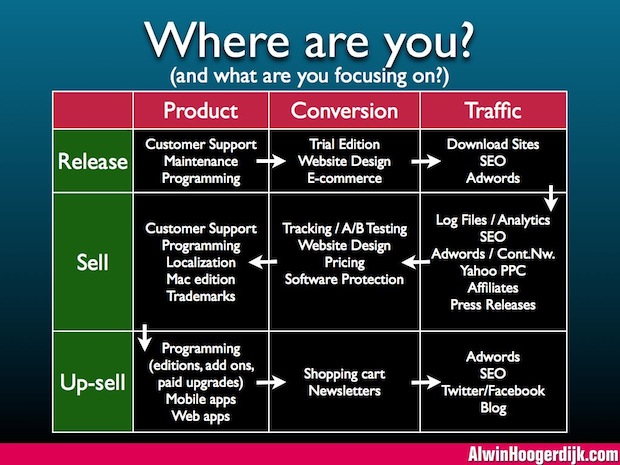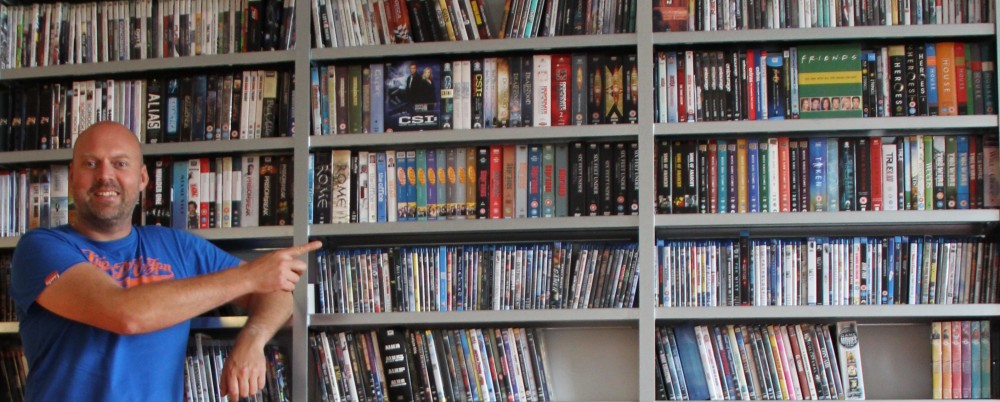As promised, the slides and full text of my “The Art of Ignoring” presentation at the ESWC 2009 in Berlin. Download it in PDF format here.
(Sorry, no video of this ESWC presentation, but you can watch the SIC 2009 video of the same presentation here.)
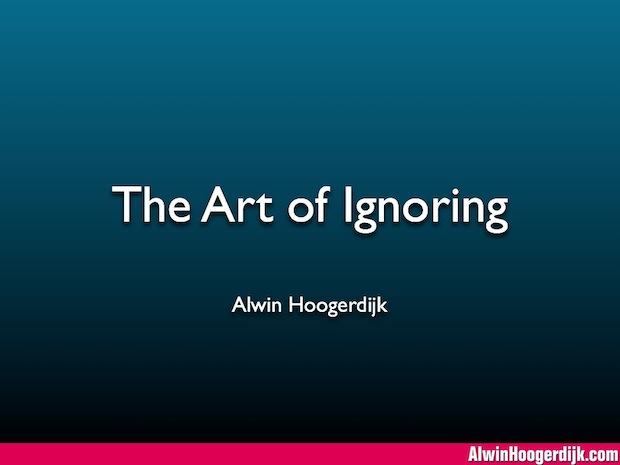
This presentation is about time-management for ISVs, about deciding what to work on at any given time. But more importantly, what to ignore.
About me
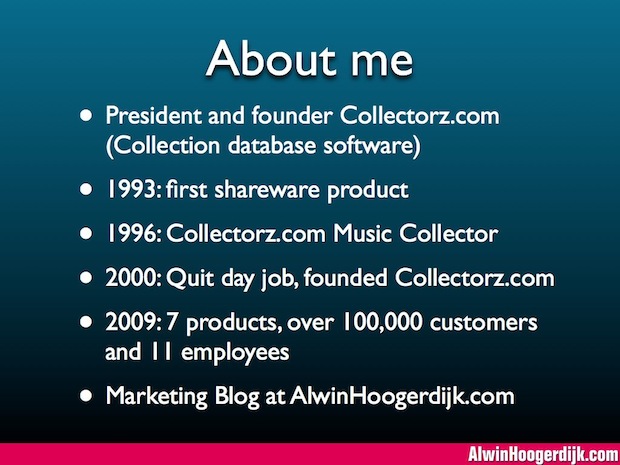
I am the President and founder of Collectorz.com.
We make “collection database software”, software for cataloging people’s personal collection of CDs, DVDs, books, comics and video games.
I have been a shareware author since 1993, but in 1996 I created Music Collector, the first Collectorz.com product, for cataloging CDs.
I worked on that one in my spare time for a couple of years, and in 2000 I was making enough money to quit my day job.
I started doing Collectorz.com full-time together with a business partner.
Now, in 2009, we have 7 products, over 100k customers and 11 employees.
Then finally, I write about software marketing on my blog at alwinhoogerdijk.com.
Things to do
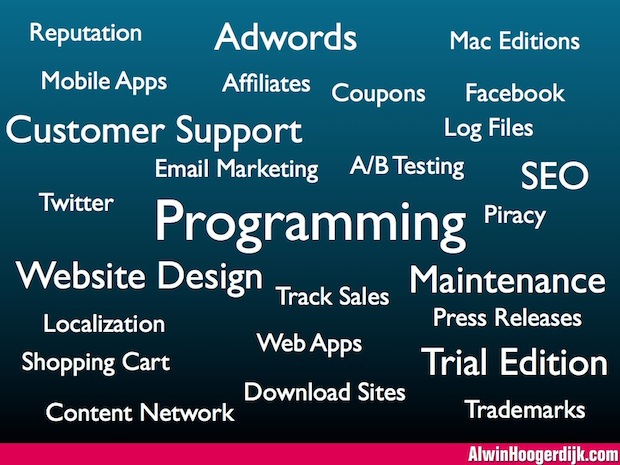
Okay then, back to the art of ignoring.
As an ISV, you spend most of your time doing Programming, Software Maintenance and Customer Support.
In 2001, that was the only thing we were doing. We had 3 products out and were getting a lot of email. Most days, we spend the entire morning doing customer support. It was only after lunch that we could finally do some coding.
Then we decided we wanted to learn more about marketing, so we went to our first european shareware conference, in Cologne. And a couple of months later we attended our first SIC, in St Louis. At these conferences, we learned that next to Programming and Customer Support, we should also:
Optimize our trial editions, improve our website design, submit to download sites, send press releases, do SEO, and Adwords, protect our software against piracy, track our sales, analyze our log files, find affiliates, create Mac editions and register your trademarks.
But that’s not all. I mean, at this conference alone, speakers are telling you that you should:
Do Twitter, and Facebook, create mobile applications, optimize your shopping cart, localize your software into other languages, develop web-applications, do A/B split testing, manage your online reputation, use the Content Network, do Email Marketing and use discount coupons.
So, what to do?
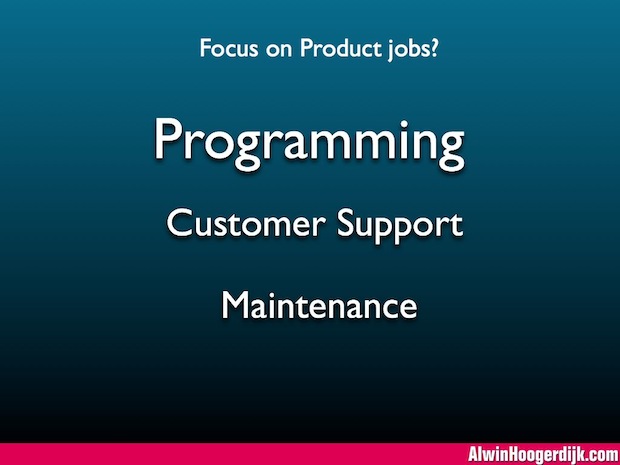
Do you keep working on Product related jobs only? Spending your time with just Programming, Customer Support and Maintenance?
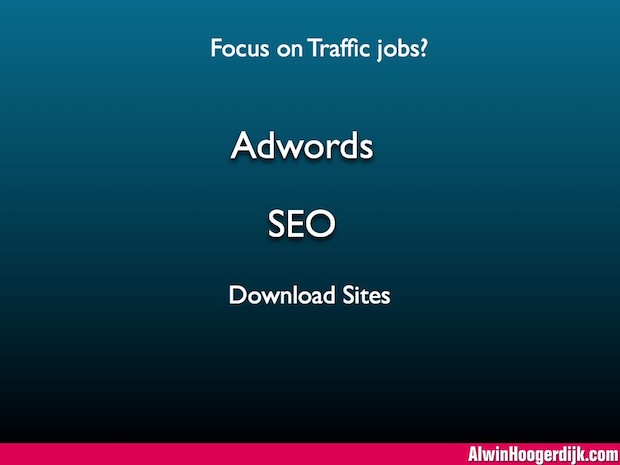
Or should you focus on getting more traffic to get your website, by doing Adwords and SEO, and by submitting your software to download sites?
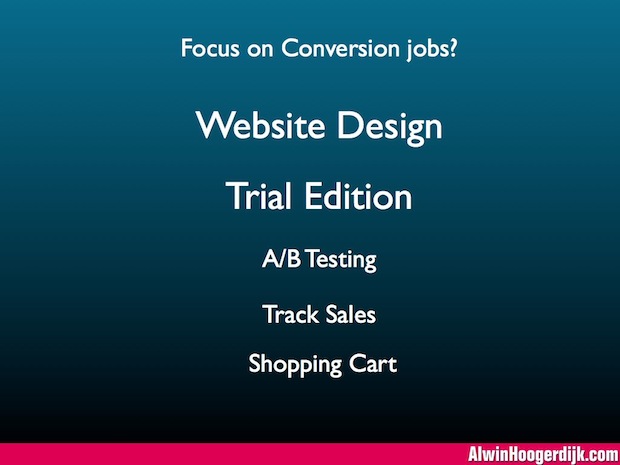
But maybe the best way to grow your business is to work on your Conversion, trying get more of your visitors to actually buy something. For example by improving your website design and by tweaking your trial edition.
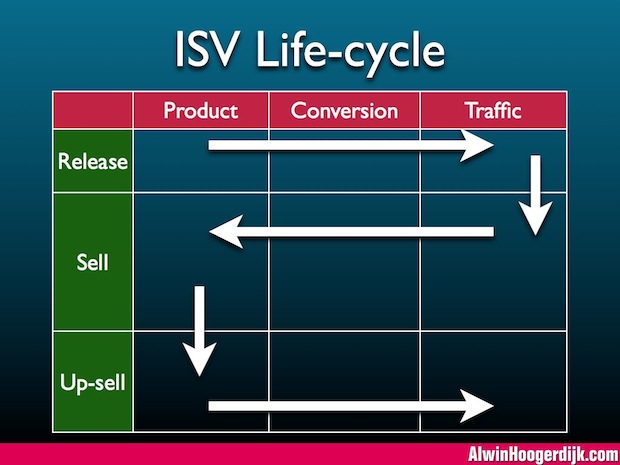
Focusing and Ignoring
The bads news is, you need to do all of these of maximize your results.
But the good news is, you don’t have to do it all NOW.
What you should focus on depends on the phase your ISV is in.
Here’s a matrix with the 3 main phases shown from top to bottom, Release, Sell and Up-sell.
Within each phase there’s 3 categories of things to do, Product, Conversion and Traffic.
Next, I will show you what to focus on, while your ISV is snaking its way from the top left to the bottom right.
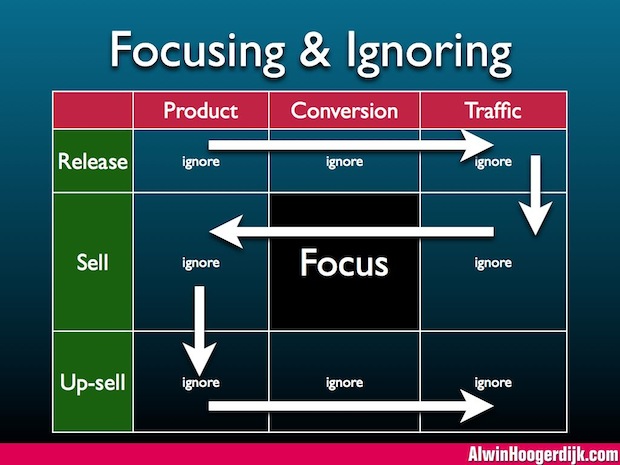
In any phase: focus on what’s important right now and ignore the rest.
Of course the hard part is to determine which jobs are important in which phase.
So lets try do that now.
Release phase
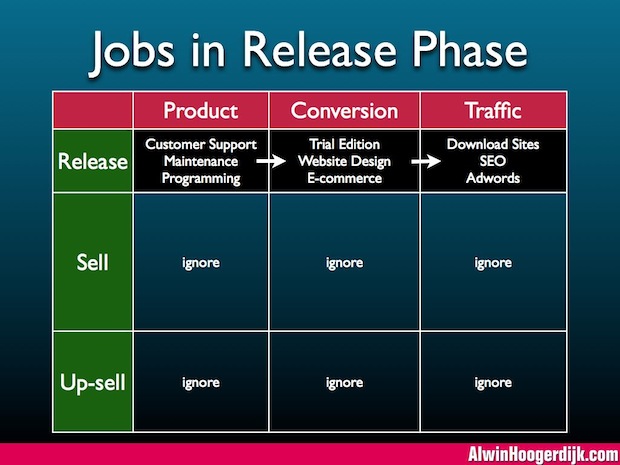
This is what I call the Release phase: Your 1.0 is out and you need to cover the basics of P, C & T.
Product
Your start with Product.
I have put Customer Support at the top, because in this phase, user feedback is essential.
Listen to your first users, fix the bugs they report, improve the user interface where they are struggling. But be careful implementing requested features. Only implement the features *you* think make sense for your product.
Back in 1996, after the release of Music Collector 1.0, I got a couple of requests to support “compilation CDs”, like movie soundtracks, where every track is by a different artist. Music Collector didn’t support those, for the simple reason that I don’t own compilation CDs myself. Of course it was a great idea, so I added it.
However, I also got requests to add CD playing functionality, which really didn’t fit a into my ideal of the ultimate CD cataloging software. So I didn’t implement that feature. And after 13 years, version 8 still doesn’t play CDs.
Conversion
For Conversion, just do the basics: Create a trial edition, which a good and obvious trial limitation. And make it easy to buy, very important.
This was one of the things I picked up at my first SIC, to have a BIG buy button in your trial edition, one that’s always visible, in any screen. Made a huge difference.
For your website, keep it simple, register your own domain and set up a one-page website, with a good headline, some feature and benefit bullets and a screenshot. Then make it very easy to download your trial edition and to buy a license.
As for e-commerce: In this phase don’t bother creating your own shopping cart or getting your own merchant account. Just use one of the full-service e-commerce solutions.
Traffic
Now you’ve got a product and a simple website, let’s get some Traffic:
Later on, download sites will become less and less important, but in this stage they are a good way to get your first traffic, downloads and links to your website. But don’t go overboard, don’t spend weeks submitting to hundreds of sites, just submit to the top 50 only and leave it at that for now, maybe even forever.
It will take a while before you will get some organic traffic from Google, so better start with SEO early. Get some links, have keywords in your page titles, write good content.
And start with Adwords now. Start low risk if you have to, switch off the content network, keep your bids low, use exact match only. But just start. And keep at it, don’t give up.
When I started doing SEO and Adwords in 2003, our sales doubled within a year. So traffic can be quite important 🙂
With a product, a simple website and some traffic, get the kinks worked out in all 3 categories, and then we’ve got the basics covered. Time to get your sales to a higher level.
Sell phase
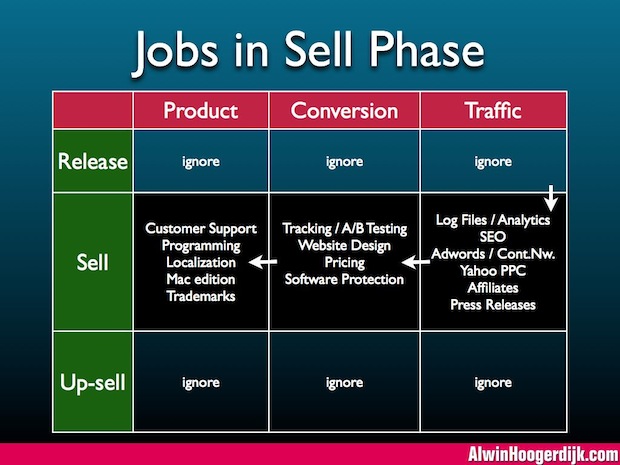
And that is what we do in the Sell phase.
Traffic
The goal here is to increase volume. The volume of visitors, downloads and sales. The ultimate goal is to build a large customer base. Resist the temptation to go back to Product and start adding new features. New features will not automatically get you more sales. You need more traffic first, so this time we go from right to left.
For Traffic, start with setting up a log file analyzer or Analytics, otherwise you’re flying blind.
When I started tracking my traffic, it soon became clear that the time I was spending on shareware sites wasn’t paying off, at all. So spend your time on SEO and Adwords instead. Maybe try Yahoo Search Marketing for you best ad groups.
Conversion
On to Conversion: With more visitors, it’s time to work on the conversion rate of your website and trial edition.
Again, set up a system for tracking and A/B testing first, otherwise you will have no idea whether the changes you are making are real improvements.
First, track the number of downloads to measure the results of website changes using simple A/B tests. And as soon as you are getting a reasonable volume of sales, you can start A/B testing pricing and checkout related changes.
Personally I love A/B split testing, I always have some test running. I am testing pricing, headlines, the location of download and buy buttons, how to use TrialPay, sometimes two completely different site layouts. For me, a week without testing feels like a week wasted.
Product
Back to Product, where we can finally do some coding again.
Your work on Traffic and Conversion should be paying off now, with more sales coming your way, and more feedback. And this feedback will help you decide which are the most popular missing features.
Still, be careful adding advanced features that will only make your existing customers happy. Focus on features that will attract new customers.
Also, to expand your market, think about localizing your software and creating Mac editions. But if you are still continuously changing and improving your product, both be a maintenance nightmare.
At Collectorz.com We have our software localized into many languages and we have mac editions of our 3 main products. And I often regret doing it, it’s a daily annoyance. So, be warned.
Now keep optimizing your Product, Traffic and Conversion, to grow your customer base.
Because a large customer base let’s you move on to the Up-sell level.
Up-sell phase
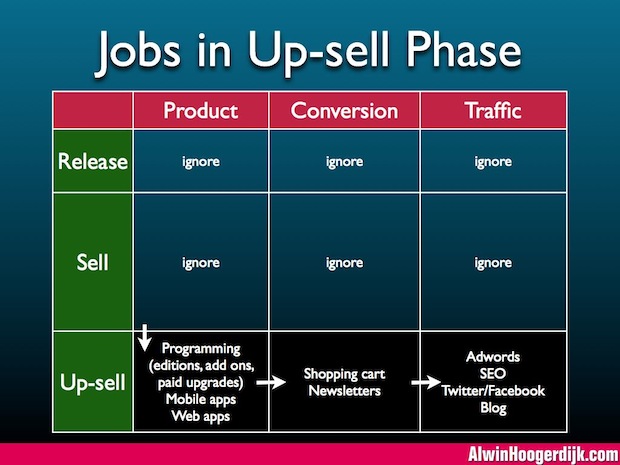
In the Up-sell phase, the goal is to make more money by up-selling and cross selling. Because nothing’s easier than selling more stuff to your existing customers.
For Collectorz.com, I started with one $25 product. Now we have 7 products each with a $30 and a $50 edition. Plus, we sell CD-ROM delivery, Priority Support, two types of barcode scanners and 5 iPhone applications. Now instead of $25 our average first purchase is around $60 and our average life-time customer value is well over $100.
Product
Anyway, before you can sell more stuff, you have to create more stuff to sell.
So we start with Product here, going from left to right again.
Remember that I told you to be careful with adding advanced features. Well, now’s your chance. But don’t give em away for free, either introduce them in a more expensive PRO edition or in add-ons.
Another great way to make money with new features is paid upgrades. Add the features, call it 2.0 and let your existing customers pay for the upgrade.
For us, we started doing paid upgrades way too late, the first time only two years ago. We made a lot of money, so last year we did it again, this time pushing the upgrade a bit harder, with several reminder emails. And we made even more money. So don’t ignore paid upgrades, biggest mistake we made.
Mobile applications and web-based applications are also great up-sells, especially if you can sell them as companion apps for your existing software.
This year we have released 5 iPhone companion apps, and we sold thousands of them, just to existing customers. And in two weeks, we will launch our first online application. And this too has been designed so that we can sell it as as additional service to our offline users.
Conversion
On to Conversion: Now that you have more products, it finally makes sense to have your own shopping cart. It will give you full control on how to present and push your up-sells and cross-sells.
Another way to sell your new stuff is email. Have a regular newsletter, just keep your existing customers up-to-date, make them aware of your new stuff. You don’t even have to be pushy about it, just let them know it’s there and they will buy it.
Traffic
As for Traffic, more products means more keywords.
Expand your Adwords and SEO to cover these. Also consider creating localized ads and landing pages, to sell your translated versions.
Then there’s Twitter and Facebook. I put them in the Traffic box because they are often presented as good ways to get new visitors. But personally, I see them primarily as a great way to stay in touch with my most eager customers.
Summary
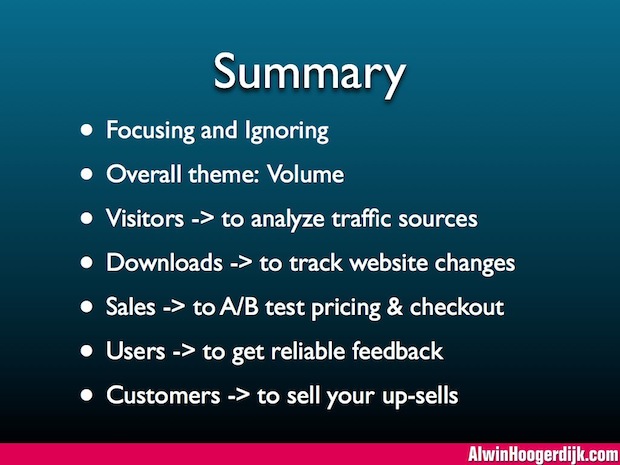
To summarize:
- Focus on what’s important in any phase, ignore the rest.
- The recurring theme here is Volume.
- You need a high volume of visitors to analyze your traffic sources.
- You need lots of downloads before you can track website changes.
- You need many sales before it makes sense to split test your pricing and other checkout improvements.
- You need many users to get enough feedback to know what really is important.
- You need to build a large customer base, before you should invest in up-selling.
